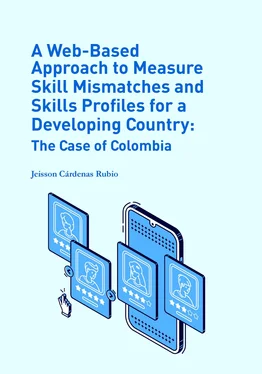3.5. Lack of accurate information to develop well-orientated public policies
In contrast with the above-mentioned classification systems in the US and Europe, Colombia does not have these kinds of advanced tools to base its education and training policies on them (González-Velosa and Rosas-Shady 2016). There exist some approaches to analyse the labour market in terms of skills, but there is not an integrated information system for skill mismatch analysis (Saavedra and Medina 2012). Institutions that have tried to measure, directly or indirectly, human capital characteristics have used different statistical approaches and skill concepts.
Since 2006, the Colombian statistics office (DANE) carries out a monthly cross-sectional household survey, the GEIH, to measure the characteristics of the Colombian workforce. The GEIH is nationally representative and constitutes the main source for official labour market information in Colombia. For instance, based on the GEIH, each month the national government publishes the unemployment rate and other relevant labour market indicators for Colombia. In this survey, people are asked about their current level of education and occupation, among other characteristics. As pointed out in Chapter 2, the level of education and the occupation of the labour force are two of the most common indicators to measure skill levels in a country.
However, for the Colombian case, this occupational analysis is limited for two reasons. First, the country’s occupational classification system has not been updated since 1970. The DANE uses in its household surveys the Standard Occupational Classification (SOC), which was established in 1970 by the Ministry of Labour and Social Protection and the SENA (Servicio Nacional de Aprendizaje), the vocational education and training institution in Colombia (Cabrera et al. 1997). The use of such outdated classifications might distort any subsequent statistical analysis due to labour market changes and new occupations that emerge or disappear over time. Occupations related to Big Data technologies (machine learning engineers, data scientists, and Big Data engineers) are representative examples, as these kinds of “Big Data” occupations did not exist 50 years ago, yet nowadays these are one of the top emerging jobs on LinkedIn (LinkedIn Economic Graph 2018).
Second, for analysis, the occupation variable is aggregated to two digits, which means that, for statistical purposes, the DANE aggregates the data into an “occupational area,” which groups different occupations together depending on their qualification level (defined by the complexity of their functions, their level of autonomy and responsibility, as well as their level of education, training, and experience) (Sánchez Molina 2013). However, as mentioned in Chapter 2, the human capital concept has evolved and encompasses different elements—for example, socio-emotional, higher-order cognitive, basic cognitive, technical skills, among others—that are relevant for the labour market and cannot be measured using an outdated and aggregated classification system. Consequently, occupational data from the GEIH is useful as it provides insights about the general labour market structure, but it does not convey detailed information about skills and important human capital characteristics in order to develop national or local public policies on human resources.
In 2012, the World Bank carried out the STEP Skills Measurement Program to measure skills in low and middle-income countries, which included Colombia (Pierre et al. 2014). This program consisted of a longitudinal household-based survey and an employer-based survey. Nevertheless, for Colombia, only the household survey is available in which people were asked about (self-reported) personality, behaviour, and time and risk preferences, among other personal characteristics, and which also measured reading proficiency and related competencies according to the Programme for the International Assessment of Adult Competencies (PIAAC) scores to allow international comparison. Questions regarding skills make the STEP survey instruments a valuable source of human capital information in Colombia. The survey sought to be representative for non-institutionalised people from 15 to 64 years of age, living in private dwellings in the thirteen major urban areas of the country. However, the general sample is composed of only 9,960 people, and after a short questionnaire, a member of the household was randomly selected to answer a more detailed individual questionnaire, which contained questions regarding skills. The total number of people who answered the skills modules is about 2,617 (Pierre et al. 2014).
Consequently, one of the main limitations of the STEP surveys is its sample size; indeed, it only represents 0.02% of the target population. Thus, the data sample cannot be disaggregated into different levels (i.e. different occupations) to make national or regional inferences due to the lack of observations. Additionally, the survey has not been updated: the first wave of information-gathering was conducted in 2012, and the second wave in June 2014; however, Colombia was not part of the second wave. 35Therefore, as noted by the OECD (2017b), the STEP approach can be used as an instrument to understand some of the general structure in the skills performance of people aged between 15 to 64 years old in each country, and allows international comparison, especially with OECD countries. However, as the labour market is dynamic and skills performance changes over time, the survey needs to be updated, at least for the Colombian case.
Additionally, both the GEIH (DANE) and STEP (World Bank) surveys are based on what people (labour supply) report. Consequently, they do not directly consider one essential part of the labour market: employer requirements. An analysis of labour demand based on what people report in household surveys is limited because it only takes into account the skills or characteristics that people possess for the labour market, but employer requirements (what is needed to fill their vacancies) remain unknown, which is an important aspect of the labour demand to understand in order to reduce possible mismatches (Autor 2001; Mavromaras et al. 2013).
The DANE carries out sectorial surveys (e.g. industrial, services, and sales-retail activities) to measure basic information, such as national account statistics, the composition of production and consumption lines, the amount of labour employed in each sector, among other indicators. Subsequently, these surveys are not designed to obtain detailed information about human capital such as occupational structure, nor about the skills required for each position. For example, regarding human capital characteristics, with these sectorial surveys it is only possible to distinguish the number of people employed by different functional areas (e.g. production, marketing and sales, investigation and development, among others). Additionally, in 2012, the DANE carried out another cross-sectorial survey named the Human Capital Formation Survey, where companies in the above mentioned three sectors were asked about job training and productivity. Although the EFCH provided valuable insights about job training, selection and hiring practices, as well as productivity, the data are still aggregated by functional areas and do not capture employer requirements.
For its part, the SENA—the institution in charge of delivering vocational education and training in Colombia—also conducts small, voluntary employer surveys (semi-structured survey questionnaires) in order to identify the occupational requirements of the private sector. However, González-Velosa and Rosas-Shady (2016) argue that these surveys do not have enough financial resources to guarantee the effectiveness of their results. Indeed, the same authors highlight that employer survey results are significantly affected by a lack of standard procedures, clarity in their objectives, and incentives for companies to participate.
Читать дальше












